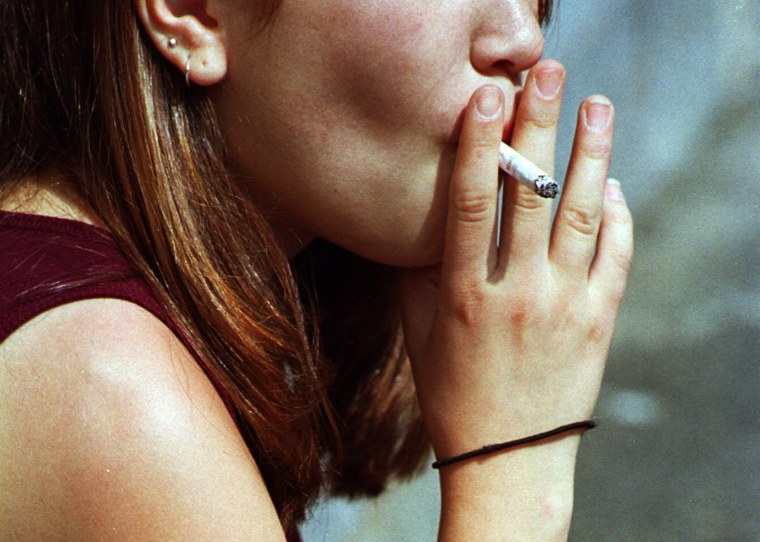Teen smoking rates have hit new lows in the U.S. and, for the first time, fewer high school students are trying e-cigarettes, new data show.
The latest report on teen smoking from the Centers for Disease Control and Prevention shows 20 percent of high school students have used at least one tobacco product recently — mostly e-cigarettes.

In past years, as fewer kids tried old-fashioned combustible cigarettes, more kids tried vaping instead. In 2016, for the first time, both vaping and smoking rates went down, the CDC reported.
“The decline in use of tobacco products was primarily driven by a drop in e-cigarette use among middle and high school students from 3 million in 2015 to just under 2.2 million in 2016,” the CDC report says.
The survey found that 11 percent of high school students had used an e-cigarette in the past 30 days at the time of the survey — the CDC’s definition of current use.
“We do know that e-cigarettes are the most commonly used tobacco product among youth and that's been the case since about 2014,” Brian King of CDC's Office on Smoking and Health told NBC News.
Here’s what the survey found:
- 11.3 percent of high school students used e-cigarettes, down from 16 percent in 2015
- 8 percent of high school students smoked traditional cigarettes
- 7.7 percent of high school students smoked cigars
- 9.6 percent of high school students said they used two or more tobacco products
- 4.3 percent of middle school students vaped
- 2.2 percent of middle school students smoked cigarettes
Smoking causes several types of cancer, heart disease, stroke and lung disease. Nicotine is highly addictive.
CDC and anti-smoking groups both said a combination of tobacco restrictions, advertising and taxes has helped reduce smoking rates.
“Comprehensive and sustained strategies can help prevent and reduce the use of all forms of tobacco products among U.S. youths,” the report reads.
But budget cuts threaten the progress, the American Lung Association said.
Related: Teen Smoking Hits New Low But More Kids Vape
“The hard-won progress our nation has made in reducing tobacco use is in jeopardy from President Trump’s 2018 budget proposal, which eliminates the CDC’s Office on Smoking and Health — the office specifically dedicated to fighting tobacco use," said American Lung Association CEO Harold Wimmer.
"Funding to states would also be severely cut, making it even harder to prevent and reduce tobacco use in local communities across the country. Congress must reconsider this ill-advised budget and robustly fund the CDC's Office on Smoking and Health," Wimmer added.
Matthew Myers, president of the Campaign for Tobacco-Free Kids, said that “the dramatic, long-term decline in youth cigarette smoking is a public health success story of extraordinary importance."
“Our progress stems directly from implementing proven strategies, including higher tobacco taxes, comprehensive smoke-free laws, effective FDA oversight of tobacco products and marketing, well-funded tobacco prevention and cessation programs, and hard-hitting media campaigns, like the campaigns conducted by the CDC, the FDA and Truth Initiative in recent years,” he added.
“In addition, California, Hawaii and over 245 cities and counties have now raised the tobacco sale age to 21.”
Related: Teens Who Try Vaping Also Try 'Real' Cigarettes
While there has not been a huge drop in teen smoking in recent years, Myers pointed out that the percentage of high school students who smoke traditional cigarettes has fallen by 72 percent, from 28.5 percent to 8 percent.
“The hard-won progress our nation has made in reducing tobacco use is in jeopardy from President Trump’s 2018 budget proposal."
“While these latest numbers are encouraging, it is critical that we work to ensure this downward trend continues over the long term across all tobacco products," said FDA Commissioner Dr. Scott Gottlieb.
Some consumer groups have expressed worries that the FDA might relax its attempts to regulate smoking. The FDA has limited power over tobacco regulation.
“The FDA has invested heavily in compelling, science-based education campaigns, such as ‘The Real Cost,’ that have already helped prevent nearly 350,000 kids from smoking cigarettes, and continues to enforce important youth access restrictions. We plan to build on these vital efforts to reduce tobacco-related disease and death,” Gottlieb said.
Related: FDA tries Hip-Hop Anti-Smoking Campaign
Certain groups still need more help, said Robin Koval, CEO of the Truth Initiative, which fights tobacco use.
“Where you live, how much money and privilege you have makes a big difference in whether you smoke. The high school smoking rate in West Virginia is more than double the rate in California,” Koval said.
“LGBTQ young adults smoke at twice the rate of the average population, and individuals with mental illness account for 40 percent of cigarettes smoked in the U.S.”
CDC also doesn’t want kids vaping.
“The e-cigarette liquids are not harmless,” King said.
“And it can contain potentially harmful constituents. Nicotine is not risk-free for kids. It is highly addictive and it can also harm the adolescent brain.”
Koval said it’s important to continue educating teens about e-cigarettes, especially as manufacturers seek new markets for their products.
“While the number of high school students who use e-cigarettes is still too high, this rapid decline is a positive indicator that much youth e-cigarette use has been experimental and that the current offering of products may be less appealing to youth than feared,” she said.

